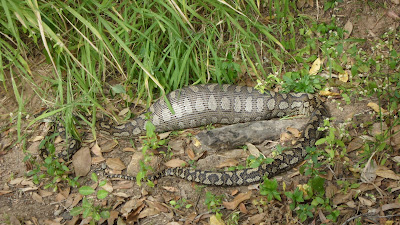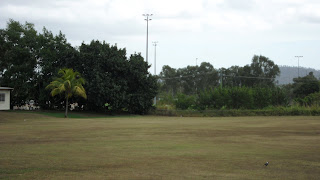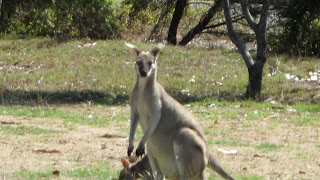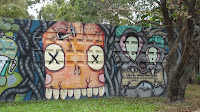Thursday, July 29, 2010
Snakes on Campus
Sunday, July 25, 2010
Things we've learned to live with
1. Ants in our pants.................literally they are everywhere.
2. Beef Jerky chicken for dinner often. We are still chewing.
3. Living in a tiny room together.
4. College kids everywhere and we thought the ants were bad!!!
5. 7 dollar coffee breaks.
6. 50% of us have internet---JCU Technology fail!
Thursday, July 22, 2010
Australian Lingo
 |
| jumper (sweatshirt lol) |
 |
| joggers (not sneakers, we don't sneak around in them.) |
brekkie- breakfast
uni-the university
bevvy- beverage
sunnies- sunglasses
whacka- idiot
bathers- bathing suit
pokies- slot machines
mozzies- mosquitoes
roadie- beer you take with you
shelia- woman
pommy shower- using deodorant instead of taking a shower
Hit the froggin toad- hit the road
root- a polite curse word "root off"
bugger- still not sure but we think it is a term of endearment
kangaroos loose in the top paddock- lost your marbles
bring your own grog bludger- bring your own beer moocher
amber fluid- beer
The funniest of the funny........................................
 |
| budgee smugglers (speedo's) |
 |
| snag |
 |
| mystery bags (yes it is found on the menu) |
Tuesday, July 20, 2010
The Dorms
The dorms here at John Flynn College are pretty nice. John Flynn College is a smaller college located on the James Cook University Campus. They have the best food on campus. We have had enough cafeteria food for a lifetime.
John Flynn Dorms
It is nicer with the door open
Outside our door
A salamander climbing our walls.
They bark haha
Wallabies feed on grass right outside our rooms.
John Flynn Dorms
It is nicer with the door open
Outside our door
A salamander climbing our walls.
They bark haha
Wallabies feed on grass right outside our rooms.
Sunday, July 18, 2010
Wombats - Nature's New and Improved Koala
Click play to see the Tonka the Wombat in Action!
Koala's are known to bring in many tourists to Queensland, giving over-exorbitant amounts of attention to the cuddliest looking of all marsupials.
But, they are among the least intelligent of their kind and native Australians roll their eyes as they explain that the Koala's brain is only the size of two peas. Their most exciting part of their day is looking at the branch in front of them, spending 23 hours a day sleeping in order to build enough energy to poo.
Our new favorite member of the marsupial clan (yes, it carries it's young in a cool pouch too) is the wombat. It is the smartest marsupial in all of Australia.
Why, you ask?
1. Wombats have a hard cartillage rear end. This comes in handy because the wombat is hunted by Dingoes and have managed to outsmart the wild dog by luring it nears it burrow. Once the Dingo is interested and sticks it head into the burrow up comes the hard cartillage butt to crush the Dingoes skull. If that is not enough, the wombat then drags the body atop his burrow mound to warn other predators lest they share the same fate.
2. The wombat is able to sense Bush fires long before other animals and during these dire emergencies, video has been taken of dingoes, snakes, padmeleons, and all other animals living in harmony in the wombats burrown while fire rages. A notable exception to this is the Koala, who is just a tad bit too "slow" to come down from the gum trees and realize there is any danger at all.
3. The hairy nosed wombat is actually in the top ten most endangered species in the world and there are only about 50 left. Farmers might be to blame, poor little buggers. (not the farmers) Our friend Tonka, is the common brown wombat and not on the brink of extinction, but super cuddly!
We hope you think that wombats are just as rad as we do! Silly cute Koalas. :P
Which do you prefer?
a. the cuddly koala
b. the wily wombat
Post your preference below!
(don't be shy now...)
Maggie Island!
Geoffry Bay
Did you know?
The name of the island came about because of the apparent "magnetic" effect it had on the ship's compass of Captain Cook as he passed the island when sailing up the east coast of Australia in 1770. People have since explored the general area of Magnetic Island with various instruments to discover what might have caused the effect that Cook reported, but nothing has been discovered. It's a mystery!sailing over on the sun ferry
Went to dinner at a restaurant called Man Friday and made some stinky friends! These possums were very keen on tortilla chips...
yum yum in my tum! shooters? give me a chip!
now i'm happy! possum on the menu (literally)
Hanging out for the day on Horseshoe Bay! So gorgeous, we went sailing on a Hobie Catamaran!
lovely day on the bay
cruising around the island in style
Tridacna gigas
Giant Clams (Tridacna gigas)
Kingdom Animalia
Phylum Mollusca
Class Bivalvia
Order Veneroida
Family Tridacnidae
Genus Tridacna (1)
Size Length: up to 1.3 m (2)
Weight up to 300 kg (2)
Life span up to 100 years
Giant clams evolved over 65 million years ago in the Eocene, along with modern corals. Both clams and corals lead symbiotic lives along with millions of single cell dinoflagellate algae called 'zooxanthellae'.
Adult clams can obtain over 90% of their food requirements from the photosynthetic products of the algae, but when particulate organic matter (POM) is present an adult clam can obtain about 33% of its carbon requirements from POM. The third source of nutrition is dissolved organic matter (DOM) but it is probably more important in larval and post-larval stages than in sub-adult and adult clams. Clams also act as natural biofilters as they take up dissolved ammonia and nitrate from the surrounding seawater to supply their symbiotic zooxanthellae with nitrogen for growth.
This enormous shellfish is the largest species of bivalve mollusk in the fossil record, and the heaviest of all the living mollusks (4). Like all bivalve mollusks, the shell consists of two valves, although in the larger giant clams these cannot close completely (5). The shell is extremely thick and lacks bony plates; when viewed from above, each valve has four to five inward facing triangular projections (5). The mantle of the clam is visible between the two shells, and is a golden brown, yellow or green, although there may be such an abundance of small blue-green circles that the overwhelming impression is of a beautiful iridescent color (5) (6). A number of pale or clear spots on the mantle, known as 'windows', allow sunlight to filter in through the mantle (5). The mantle is completely fused with the exception of two holes (or 'siphons'). The gills are visible through the inhalant siphon, while the exhalent siphon is tube-like and is capable of expelling a large volume of water during spawning or if the clam’s shells close suddenly (7) (6).
See video.
These huge bivalve mollusks are found in shallow waters of the Pacific Ocean, from Thailand and Japan to Australia and Micronesia (1). However, the giant clam’s range has reduced since the 1970s due to over-harvesting (6).
Adult giant clams are completely sessile, unable to move from their position on the coral reef. They reproduce by expelling sperm and eggs into the sea (5), where fertilization occurs. The fertilized eggs quickly enter a swimming stage, (where they are known as trochophores), before entering a planktonic stage (6). During this stage, the larvae, (known as 'veligers'), inhabit the open ocean for one week, before settling in the substrate. If a clam is disturbed it will close its shell valves (5).
Giant clams have an inhalant siphon, which they use to draw in seawater that is then filtered for planktonic food (5). The majority of the clam's nutrients however, are obtained by a mutually beneficial relationship with minute algae known as zooxanthellae (5). These plant-like algae exist in delicate tubules which are extensions of the stomach (8). The algae gain protection from predators by being associated with such a large organism, while the clam obtains the carbon by-products of photosynthesis (9). Giant clams also provide protection for a species of pea crab (Xanthasia murigera); a single pair will often be found living within the cavity of the clam (7).
References
- IUCN Red List (February, 2008)
- Spalding, M.D., Ravilious, C. and Green, E.P. (2001) World Atlas of Coral Reefs. University of California Press, Berkeley.
- CITES (August, 2002)
- Wye, K. (1991) The Illustrated Encyclopedia of Shells. Quintet Publishing Limited, London.
- Animal Diversity Web (August, 2002)
- Braley, R.D. (2008) Pers. comm.
- Mead and Beckett Publishing. (1984) Reader's Digest Book of the Great Barrier Reef. Reader's Digest, Sydney.
- Norton, J.H. and Jones, G.W. (1992) The Giant Clam: An Anatomical and Histological Atlas. ACIAR Monograph, Canberra.
- Monterey Bay Aquarium (August, 2002)
- Braley, R.D. (1992) The Giant Clam: Hatchery and Nursery Culture Manual. ACIAR Monograph No. 15, Canberra.
- Norton, J.H., Braley, R.D. and Anderson, I.G. (1993) A quarantine protocol to prevent the spread of parasitic diseases of giant clams (Tridacnidae) via translocation. In: Fitt, W. (Ed) The Biology and Mariculture of Giant Clams. ACIAR Proceedings No. 47, Canberra.
Wednesday, July 14, 2010
Video of Algae taken at Liz's Lab!
Click the play button
I'm just proud of myself for being able to take the video and manage to get it online! Sweet! Now you can see live action of algae swimming around under the microscope.
Cell Culturing with Liz
mad scientist? liz working on cultures
The past couple of days in the lab have been dedicated to culturing. This means spending 2 – 3 days transferring each type of algae to new medium, thus supplying it with enough nutrients for another 3 – 6 weeks of survival. Cultures need to be aerated in order to ensure that each organism gets a fair shot at the light and to ensure that bacteria won’t be able to feed off of dead culture.
just some of species of algae in the culture bank
Marine and freshwater species are cultured, of both flagellates (remember, algae with flagella to help it get around, and diatoms (those with the hard armored exterior, composed of silica). There were a few other types of algae that will be culture tomorrow as well: cyanobacteria, epiphytes, as well as cryptophytes. The classification of all the different species still eludes me and I will be wikipeda-ing the heck out of all these terms this evening.
algae (optical microscope) algae (scanning electron microscope)
An example of a growth medium that is commonly used by many of the organisms is called L1. It involves taking sterile sea water from the reef near Orpheus Island (where Elise collected her coral samples!) The reason seawater is used from this area is because there is no contamination by runoff near largely populated areas, lets say like Townsville. Into this then goes .5mL of a vitamin solution, and 1mL of each of the following: trace metals, phophate, nitrate, and silica. Interestingly, only the diatoms use the silica to make their glass armor and if it isn’t used it starts to form sheets. This growth media can be stored until needed for culturing.
silica sheets
So all of this might not sound too hard (and once you get the gist of it, really it isn’t) but try learning all of this from Stan with his kiwi accent. At one point he asked me to get the white tips from the next room, so I brought him the white box of pipette tips and he laughed at me! “Tape! The white tape, I said” he goes… I’m telling you it’s like I’m in my very own episode of Flight of the Conchords.
Hello, my name is Brit (Brett). You’ve got to just watch the show. J
Wallabies on Campus!
The name wallaby comes from the Eora Aboriginal tribe who were the original inhabitants of the Sydney area. Young wallabies are known as "joeys", like many other marsupials. Aren't these guys adorable?


Tuesday, July 13, 2010
Want to Know More About Coral Bleaching? Here is a Summary of Current Literature!
Effects on climate change were first recognized on coral reefs. Climate change affects coral reefs in many ways. Increased intensity of tropical storms and increasing ocean acidification both have a negative effect on coral. Bleaching refers to the whitening of zooxanthellae organisms due to the loss of the symbiotic relationship between corals and zooxanthellae. Since 1964 scientists have found 7 major bleaching events affecting corals. The threat of climate induced bleaching has caused many scientists to look into associations between zooxanthellae and their host corals.
Scientists have found that coral bleaching almost always results from declines in zooxanthellae densities. They have also found there are many causes to coral bleaching such as aerial exposure, cold shock, insecticide, pollutants, sedimentation, and of course temperature changes. Researchers have found that during bleaching events corals must rely on stored energy or utilize heterotrophic feeding to stay alive.
Severe bleaching usually results in the mortality of the coral because the animal tissue that house the zooxanthellae become damaged. It looks as if more research must be conducted to account for natural variation of zooxanthellae and bleaching events that cause lower levels of zooxanthellae in coral.
There are many natural occurrences that give way to mortality of coral such as seasonal and depth related differences in zooxanthellae densities. Scientists have found it is important to distinguish between families of coral when assessing natural densities of zooxanthellae because some types of coral have naturally low levels of zooxanthellae.
It has also been found that some coral species are more susceptible to coral bleaching than others. Scientists know that coral bleaching is disturbing whole reef ecosystems and the health of coral reefs worldwide is expected to decline. From the various articles discussing coral research I have learned we as teachers should follow in the footsteps of research scientists and educate our students as they educate about our everyday behavior that is attributing to the degradation of our precious coral reefs. I will be sure to involve my students in the incredible importance of learning about our coral reefs.
Classroom Application of Elise’s Lab Experience
So I have been thinking long and hard on how I can introduce my students to coral reef conditions and I have thought of a few ideas. First I will familiarize them with sea surface temperatures and the use of satellites to detect them. NOAA has some great free online programs that I have used with my students before in addition to many other free programs that help monitor conditions on earth. http://coralreefwatch.noaa.gov/satellite/
Second I would like to introduce students to the effect of sea surface temperature on overall coral health. I will have students look into coral reef ecology and the impacts of climate change. At Curtis High School we have many available laptops that students can use during class to look at simulations about coral bleaching. I plan on having students look at past mass bleaching events and what the sea surface temperatures were when these bleaching events occurred.
 Students will come up with reasons why bleaching events have occurred by researching some journal articles and literature that discuss climate change. I will also have students familiarize themselves on how to find educational sources online using webquests. Students will answer questions together as groups on why coral reefs are important and what would happen if they were destroyed.
Students will come up with reasons why bleaching events have occurred by researching some journal articles and literature that discuss climate change. I will also have students familiarize themselves on how to find educational sources online using webquests. Students will answer questions together as groups on why coral reefs are important and what would happen if they were destroyed. Since I have looked into zooxanthellae I will teach students about the symbiotic relationship between coral and algae. I have preserved slides of my samples that we can look at in class and discuss further this partnership.
Background information will be provided in the beginning of the week’s lesson so students get a broad idea of what is going on in terms of coral conservation and research.
I will plan some discussion questions as well as have students come up with questions about coral reef conservation and connectivity. This will help students come up with problem solving techniques that are important in critical thinking. There are also additional satellite programs I will look into to monitor other aspects of the earth and link how technology can be found elsewhere besides just in video games.
Monday, July 12, 2010
Artwork on campus
The students are very creative on campus. From their graffiti to their mosaics, we were thoroughly impressed!
Subscribe to:
Comments (Atom)















































